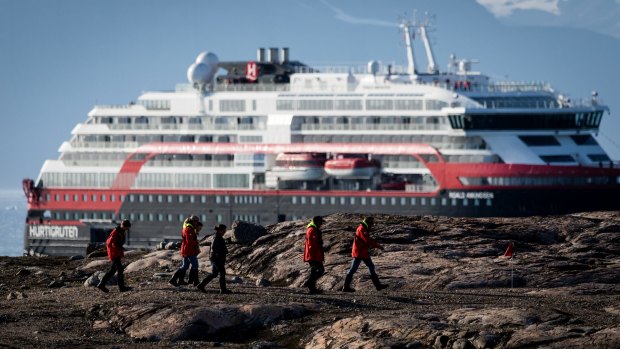This was published 4 years ago
Greenland cruise: Hurtigruten's MS Roald Amundsen is the world's first hybrid cruise ship
By Andrew Bain

As Greenland's ice melts, MS Roald Amundsen, the world's first hybrid cruise ship, launches.Credit: Oscar Farrera
From beneath the Greenland ice sheet, a torrent of water pours over the cliffs, crashing into a gully in a plume of spray. It's a powerful sight, but it's also, conversely, a sign of the fragility of this vital ice sheet that covers around 80 per cent of the world's largest island.
In just one day that I'm cruising along Greenland's east coast, a record 11 billion tonnes of water will melt into the ocean from the island. In July 2019, almost 180 billion tonnes of fresh water poured into the sea. Stand and watch it happening from the deck of a ship, and the sustainability of cruising seems an especially pertinent subject.
"If the cruising industry was a country, we'd be the sixth-largest emitter of carbon-dioxide emissions in the world," says Damian Perry, Asia-Pacific managing director for Hurtigruten. "That's how crucial this issue is."
The ship on which I'm sailing may be at the forefront of change. Hurtigruten's MS Roald Amundsen, which had its maiden voyage in July, is the world's first hybrid cruise ship. Marine diesel engines power the ship, assisted by up to eight lithium ion battery packs in a system known as peak shaving. When the ship needs additional power to its normal operation, it's supplied by the batteries rather than diesel, cutting out spikes in the use of fuel. Hurtigruten claims the hybrid technology will reduce the 21,000-tonne ship's fuel consumption and carbon-dioxide emissions by 20 per cent, or around 3000 tonnes of carbon dioxide a year.
Coupled to this are other energy savers and sustainable shifts. The water used to cool the Roald Amundsen's engines in turn becomes the hot water in showers, spas and the swimming pool, while the hull is specifically designed to reduce water drag. In the ship's main restaurant, Aune, food waste is reduced by serving buffet dishes in small ramekin bowls. You can eat as much as you like, but it becomes a conscious decision rather than an unthinking heaping of a plate.
The Roald Amundsen, which has capacity for 530 passengers, also marks a change in the design and style of Hurtigruten's expedition ships. It contains two main communal living areas: the large Explorer Lounge, which is the place to sit and watch polar scenes spool past; and a science centre, which is perhaps the biggest change the Roald Amundsen brings to ship life. Among cabinets with displays of skulls, teeth and claws from the likes of polar bears, orcas, walruses and narwhals, the science centre has a vast library of references book and natural history guides. There are chairs in which to recline and read, and two round tables of microscopes and slides, including a prized $50,000 stereo microscope and a polarised light microscope for viewing slivers of rock.
Most compelling of all is an interactive digital tabletop map on which passengers can zoom in and out of places anywhere in the world. Other features on the $450-million Roald Amundsen include a spa, gym, a sauna with floor-to-ceiling window views, and artworks personally chosen by Norway's Queen Sonja. The three restaurants include the fine-dining a la carte Lindstrom and the Scandi-cool Fredheim, dishing up burgers, dumplings and the like.
The Roald Amundsen will be the blueprint for Hurtigruten's future expedition fleet. The company is currently refurbishing all of its expedition ships to match the look of the Roald Amundsen, including a science centre in each.
The hybrid technology will also spread through Hurtigruten's fleet. A new expedition ship, the Fridtjof Nansen, is under construction, and when it's launched next April, it will set sail with four battery packs (the Roald Amundsen is currently running one battery pack as Hurtigruten monitors advances in battery technology). The rest of the expedition fleet is expected to be converted to hybrid technology by 2021, marking another step in Hurtigruten's ambition to becoming the world's first zero-emission cruise operator.
"The technology to do that doesn't exist, but the technology to run a battery-powered ship didn't exist 12 months ago," Perry says. "If we can harness changes in technology into ship technology, we're moving quickly towards zero emissions."
TRIP NOTES
Andrew Bain travelled courtesy of Hurtigruten and Inspiring Vacations.
MORE
CRUISE
From November to April, the Roald Amundsen will be sailing in Patagonia and Antarctica. Next year's sailings include Central America, Alaska and British Columbia, and the Northwest Passage. Inspiring Vacations books Hurtigruten cruise packages that include all airfares, accommodation and transfers, starting from $7999. See hurtigruten.com.au; inspiringvacations.com
Sign up for the Traveller Deals newsletter
Get exclusive travel deals delivered straight to your inbox. Sign up now.